1. Paul Bunyan and Babe the Blue Ox – Bemidji, Minnesota
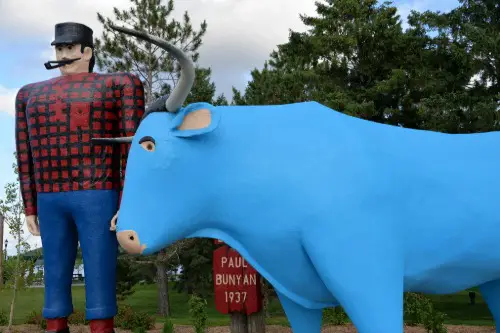
This towering statue duo has been luring in travelers for decades with their impressive size, Atlas Obscura explains. Paul Bunyan, the legendary lumberjack, never actually existed, but that hasn’t stopped multiple states from claiming him. The Bemidji statues, built in 1937, were among the first to cement the town’s claim to the folklore icon. Tourists love snapping photos with them, even though they’re completely fictional characters.
Adding to the illusion, there used to be a loudspeaker that made Paul “talk” to visitors. This trick convinced kids (and some adults) that the statue was alive. Today, the statues are purely for show, but they remain one of the most photographed roadside attractions in the country. Even though Paul Bunyan is just a myth, his oversized legacy lives on.
2. The Cardiff Giant – Cooperstown, New York
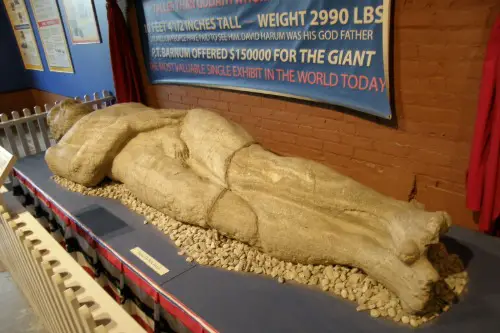
This so-called “petrified man” was actually one of the greatest hoaxes in American history, according to the Massachusetts Historical Society. Back in 1869, a businessman named George Hull had the 10-foot-tall figure carved out of gypsum, buried it, and then “discovered” it to fool the public. People flocked to see what they believed was a fossilized giant, and even P.T. Barnum got involved, creating his own fake version. Today, the Cardiff Giant sits in the Farmers’ Museum in Cooperstown, fully exposed as a fraud.
Even after it was debunked, some people refused to believe it was fake. Scientists quickly pointed out that the statue had clear chisel marks, proving it wasn’t ancient. That didn’t stop the original investors from making a fortune off ticket sales before the hoax collapsed. Now, it’s mostly a fun relic of America’s long history of strange scams.
3. The Oregon Vortex – Gold Hill, Oregon
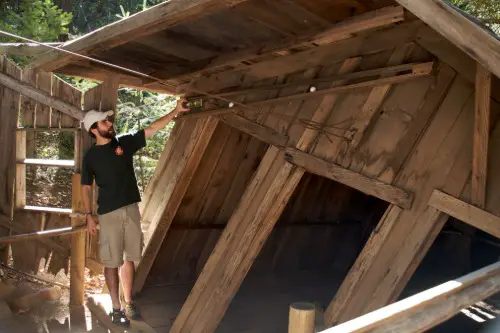
The Oregon Vortex is famous for making visitors feel like the laws of physics don’t apply. Balls roll uphill, people appear to grow and shrink, and no one seems to stand straight. The attraction claims it’s due to a mysterious “vortex” disrupting gravity, but in reality, it’s just a well-designed optical illusion. The tilted structures and sloped ground trick your brain into perceiving things that aren’t really happening.
Despite the scientific explanation, the legend of the vortex keeps the place popular. Guides love to sell the idea of strange forces at work, adding a bit of mystery to the experience. Visitors often leave convinced they saw something supernatural, even though it’s all just perspective tricks. Whether you believe in weird energy fields or not, it’s a fun stop on an Oregon road trip.
4. The Mystery Spot – Santa Cruz, California

The Mystery Spot claims to be a “gravitational anomaly” where normal physics don’t apply. People seem to lean at impossible angles, and objects roll in unexpected directions. In reality, it’s another classic case of tilted architecture messing with human perception. The slanted house and uneven floor create visual distortions that trick your sense of balance.
Even though it’s been debunked, the Mystery Spot still markets itself as a scientific enigma. Visitors love the feeling of being “inside” an unsolved mystery, even if the answer is just clever construction. Tour guides keep up the act, making the experience more fun for everyone. Whether you go for the science or the spectacle, it’s an entertaining stop on a California road trip.
5. Lucy the Elephant – Margate, New Jersey

Lucy the Elephant is a massive, six-story elephant-shaped building near the Jersey Shore. Built in 1881 as a real estate gimmick, it was never meant to be anything more than a roadside spectacle. Over the years, it’s been a hotel, a bar, and a tourist attraction, but it’s always been just a quirky, man-made structure. Despite rumors, it was never an ancient temple or a relic from a lost civilization.
People love to believe Lucy has some deeper history, but she’s purely a product of American roadside kitsch. That doesn’t make her any less impressive, though—she’s the oldest surviving roadside attraction in the U.S. Today, Lucy is a National Historic Landmark, proving even fake attractions can earn real recognition. If you’re ever in New Jersey, she’s worth a visit for the sheer oddity of it.
6. Carhenge – Alliance, Nebraska
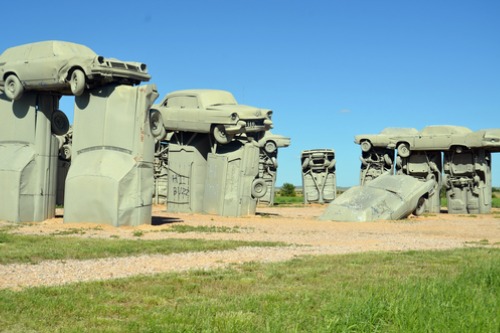
Carhenge is exactly what it sounds like—a replica of England’s Stonehenge, but made entirely of old cars. Built in 1987 by artist Jim Reinders, it’s a tribute to the ancient monument with a distinctly American twist. Unlike the original, which dates back thousands of years, this one is barely a few decades old. Yet, some visitors still show up expecting an ancient mystery.
Despite its artificial nature, Carhenge has gained fame as one of the most unique roadside attractions in the U.S. It’s been used for everything from art exhibits to UFO conventions. Over time, it has taken on a life of its own, with additional sculptures added to the site. It may not have historical significance, but it’s definitely an unforgettable stop in Nebraska.
7. The Lost Sea – Sweetwater, Tennessee
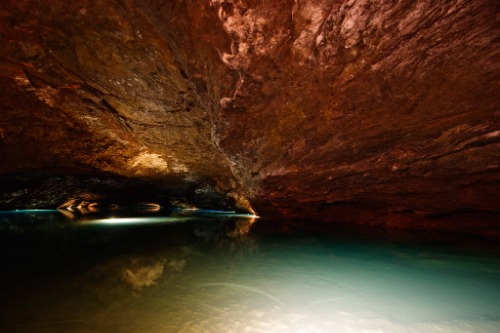
The Lost Sea is advertised as America’s largest underground lake, but that’s not entirely true. While there is a real underground lake in the caverns, much of what visitors see is artificially controlled. The tour includes a boat ride over a small section of water that looks bigger due to strategic lighting. The natural lake does exist, but the way it’s presented is designed to exaggerate its scale.
Even the fish in the lake aren’t native—they were added to make the experience feel more authentic. The cave itself is impressive, but the “sea” part is mostly a tourist-friendly illusion. That doesn’t stop people from believing they’ve seen a natural wonder. If you don’t mind a little exaggeration, it’s still a fun stop in Tennessee.
8. The World’s Largest Ball of Twine – Cawker City, Kansas
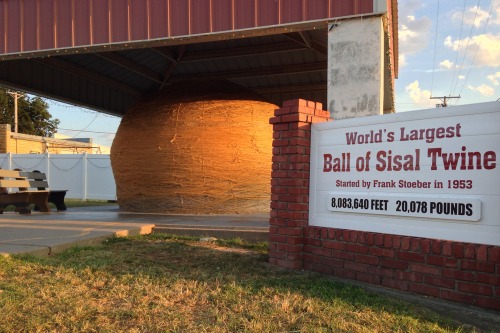
Kansas is home to one of the strangest competitions in the world—who has the biggest ball of twine? The Cawker City ball is the most famous, but it’s not the only one, and it’s constantly being added to. Unlike what some visitors believe, it didn’t just naturally accumulate—it was started by a man named Frank Stoeber in 1953. Over time, the town turned it into a tradition, letting visitors add their own twine.
The ball itself is massive, but its “largest” title is always in dispute. Other towns have competing twine balls, each claiming to be bigger based on different rules. Despite the ongoing debate, Cawker City’s version remains the most visited. Whether it’s truly the biggest or not, it’s a prime example of how small towns turn anything into a roadside attraction.
9. Foamhenge – Natural Bridge, Virginia
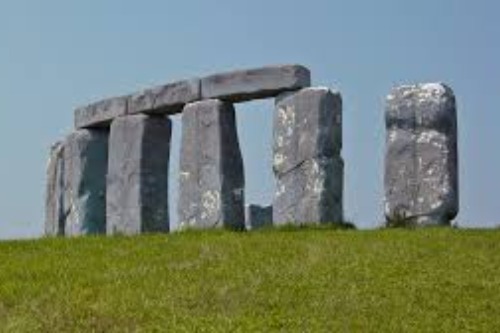
Foamhenge is exactly what it sounds like—a full-scale replica of Stonehenge made entirely of Styrofoam. Created by artist Mark Cline in 2004, it was originally built as an April Fool’s joke but quickly became a permanent attraction. Unlike the original Stonehenge, which weighs thousands of tons, these “stones” are light enough to be moved by hand. Some visitors show up expecting something ancient, only to realize it’s just a giant art project.
Despite its artificial nature, Foamhenge has gained a cult following. People love posing with it, pretending they’ve discovered an ancient wonder in rural Virginia. The attraction was temporarily removed in 2016 but found a new home at Cox Farms, where it still draws curious travelers. It may not have any historical significance, but it’s a fun roadside stop for anyone who loves weird Americana.
10. The Thing – Dragoon, Arizona
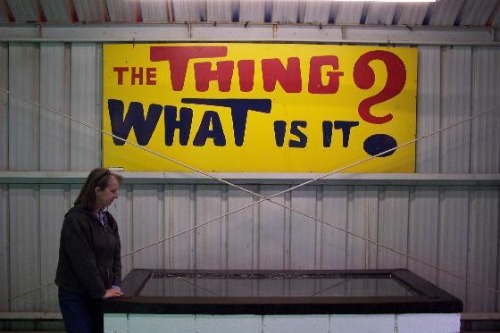
The Thing is one of the most mysterious roadside attractions in America, but not for the reasons you might expect. Billboards along the highway build up the suspense, teasing travelers with “What is The Thing?” for miles before they reach the site. When they finally arrive, they find a bizarre roadside museum filled with oddities, with the so-called “Thing” itself being a mummified figure of unknown origins. The problem? It’s almost certainly fake.
Experts believe The Thing is just a cheaply made reproduction, possibly inspired by sideshow mummies from the past. The rest of the museum is filled with oddball exhibits that mix real artifacts with nonsense conspiracies. Despite this, it remains one of Arizona’s most iconic roadside stops. Whether you believe in the mystery or just want a weird story to tell, it’s worth a visit.
11. The Cabazon Dinosaurs – Cabazon, California
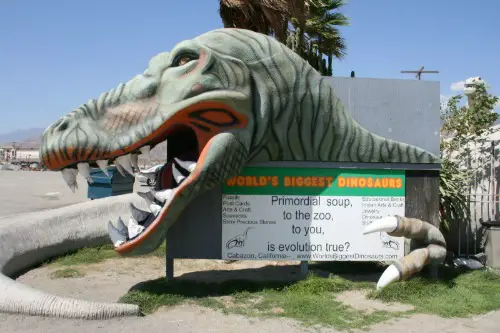
These massive roadside dinosaurs are an iconic sight along Interstate 10, but they have no real connection to prehistoric times. Built in the 1960s by sculptor Claude Bell, the dinosaurs were originally meant to attract customers to his restaurant. The two biggest dinosaurs, Dinny the Dinosaur and Mr. Rex, are made of concrete and steel, with hollow interiors that once housed gift shops. Despite their artificial nature, they’ve been featured in movies, including Pee-wee’s Big Adventure.
Over the years, the attraction has taken on a strange twist. It was purchased by a group that turned it into a creationist museum, claiming dinosaurs lived alongside humans. The original builder never intended this, making the whole thing even more bizarre. Whether you go for the nostalgia or the sheer weirdness, the Cabazon Dinosaurs remain a must-see roadside oddity.
12. Salvation Mountain – Niland, California
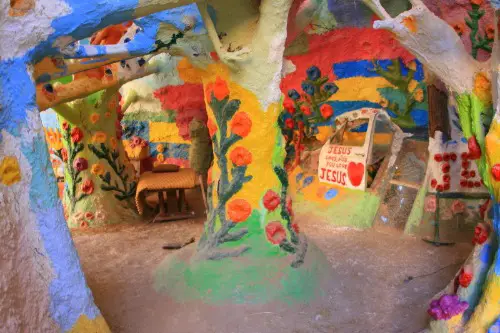
Salvation Mountain looks like a natural rock formation covered in colorful paint, but it’s actually a massive man-made structure. Built by Leonard Knight over decades, the mountain is made of adobe, straw, and thousands of gallons of brightly colored paint. It serves as a religious monument, with messages of love and faith covering every inch. Though it looks like a natural hill turned into an art piece, it’s entirely human-made from the ground up.
Despite its artificial origins, Salvation Mountain has gained national recognition. It’s been featured in movies, music videos, and even designated a national treasure by the Folk Art Society of America. Visitors love climbing on it and taking pictures, but the structure is fragile and constantly needs repairs. Whether you’re religious or just appreciate eccentric roadside art, it’s one of California’s most unique stops.
13. The Spouting Horn – Depoe Bay, Oregon
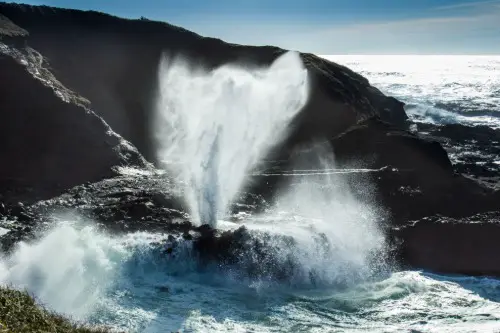
The Spouting Horn is often advertised as a natural geyser, but it’s really just an ocean blowhole. When waves crash into a cave beneath the rocks, the water shoots up through an opening, creating an impressive fountain. Tourists sometimes believe it’s a hot spring or volcanic vent, but there’s no geothermal activity involved. The “roaring” sound that accompanies it is just air being forced through the rock.
Despite not being an actual geyser, the Spouting Horn is still an incredible sight. Depending on ocean conditions, the water can spray dozens of feet into the air. Many people prefer the illusion, as it makes the phenomenon feel even more dramatic. Even though nature is doing all the work, the way it’s often presented makes it seem far more mystical than it really is.


